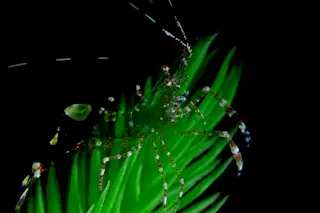The last glimmer of sunlight disappears in the ocean’s twilight zone, a region that spans 200 to 1,000 meters in depth and has light levels similar to a starry night. Predators in this region tend to have eyes that face upward, like the hatchetfish and cockeyed squid; this is better for scanning the water above for silhouettes of potential prey.
But to veil their silhouettes, many of the twilight zone’s animals have evolved to become transparent. It’s helpful to be transparent in shallower waters too, of course. Take the anemone shrimp, which lives in waters shallower than 20 meters deep and is so transparent you could read a book through its body.
But in the ocean’s twilight zone, transparency has really taken off. “I think you can find transparent representatives from every single animal phyla in the midwater,” says Laura Bagge, a visual ecologist at Torch Technologies who works as ...














